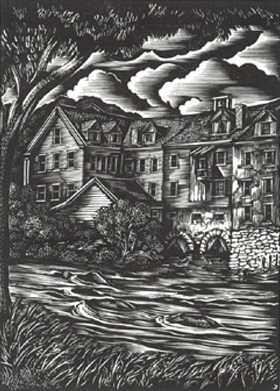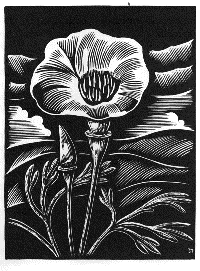 |
| From “Anthology of Delaware Papermaking” with four wood engravings by John DePol, Oak Knoll Books, 1991. |
The University of Delaware Library has acquired the papers of John DePol, one of America’s most accomplished contemporary book artists and illustrators. Regarded as one of the country’s preeminent wood engravers, DePol is an accomplished artist in a variety of media and techniques, including etching, lithography, watercolor and oil painting.
The papers, which span nearly 100 linear feet in their unprocessed state, were acquired by a combination of gift and purchase directly from DePol. An exhibition of the work is scheduled for fall 2004.
DePol was born in 1913 in Greenwich Village. By the age of 16, he was working as a statistical clerk and securities runner on Wall Street, and continued to work in the financial district until the outbreak of World War II.
Although DePol had no formal art training and is largely self-taught, he attended night classes in lithography at the Art Students League in New York. From 1943 to 1945, he served in the U.S. Army Air Force, and while on duty in Northern Ireland continued his lithography studies at the College of Art in Belfast. During this period, he sketched the sights and scenes of Ireland, images which would later form the basis for a series of wood engravings and a 1982 exhibition catalog, “Ireland Remembered: A GI’s Recollections.”
 |
| Wood engraving by John DePol for “California Flora” by Elizabeth May McClintock, San Francisco, Book Club of California, 1995. |
After being discharged from the service, DePol returned to New York, married Thelma Roth, and went back to work on Wall Street, although his interests lay elsewhere. In 1950, he became a production assistant with Lewis F. White & Co., a small commercial printing firm in New York.
His new job provided the opportunity to learn all aspects of the printing business, including typography and graphic design. Throughout this period, DePol continued to develop as an artist, refining his techniques as a printmaker, especially wood engraving, in which he had been seriously engrossed since 1947.
By the mid 1950s, he began to accept independent commissions illustrating private-press booklets, separate prints, broadsides and limited edition books. In 1952, his work was chosen to appear in a series of publications by The Woodcut Society. In 1953, he began illustrating the Ben Franklin Keepsake editions for the annual New York Printing Week celebration and continued to do so for the next 30 years.
DePol was soon recognized as one of the premier American wood engravers and over the next several decades worked with some of the best-known fine-press printers, including Lewis and Dorothy Allen (The Allen Press), John Anderson (The Pickering Press), John Fass (Hammer Creek Press), the Typophiles, Arthur Rushmore (The Golden Hind Press), Barnard Taylor (Press of Appletree Alley), Steve Miller (Red Ozier Press), Morris A. Gelfand (The Stone House Press), Jan and Crispin Elsted (Barbarian Press), Neil Shaver (Yellow Barn Press) and a host of others.
During the course of his long career, DePol also continued to do commercial work and produced keepsakes, invitations, booklets and illustrations for magazines, corporations, publishers, foundations and academic institutions.
DePol maintained meticulous records of his commissions and his own independent work. His papers contain virtually all of his correspondence and memoranda relating to jobs, contractual material, preliminary renderings and sketches, photographs, proof material, examples of the final printed work, original woodblocks and files relating to the artists, printers and publishers with whom he has worked.
One of the largest and most important groups of papers documents the long, productive collaboration between DePol and Anderson of the Pickering Press. The two worked together for nearly 40 years and produced numerous pamphlets, chapbooks, broadsides, keepsakes, Christmas cards, letterheads and ephemera, all of which are represented in the collection.
 |
| Artist John DePol, 85, at work. |
DePol also is a dedicated student and collector in the history and craft of printing, and his papers include a wealth of material relating to these interests, including books from his personal library, original prints and artwork. Of particular note are original letters, photographs and documents pertaining to Frederic Goudy, Bruce Rogers, John Fass and other important figures.
“The University of Delaware Library is honored to be the home of the John DePol papers, a landmark figure in American book arts,” Susan Brynteson, the May Morris Director of Libraries, said. “The John DePol papers are a significant addition to our strong archival holdings on the history of printing and are an important complement to such existing collections as the Archives of the Bird & Bull Press, the Plough Press, the Pentagram Press and the Blackstone Press; the papers of J. Ben Lieberman and Fridolf Johnson; and significant archival holdings centering around Paul A. Bennett, Lester Douglas, Frederic Goudy and Arthur Rushmore.”
|

